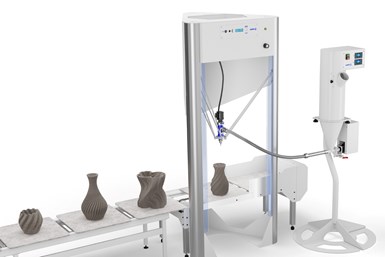Wasp Polymer, Ceramic 3D Printers for Customized Serial Production
Formnext 2022: Italy-based Wasp offers 3D printing options for sustainable, customized serial production with polymers and ceramics.
Wasp’s latest lines of 3D printers include a line for fluid-dense materials and one for polymeric materials.
For the 3D printing of fluid-dense materials using Liquid Deposition Modeling (LDM), the company says it has three innovations, including an entire customized serial production line for clay, which is a novel tool that changes the vision to a new concept in production by mixing the capacities of additive technology (hence customization) with mass production. The second innovation is a continuous feeding system that eliminates micro air bubbles while also enabling an uninterrupted print feed. For those who print cements, geopolymers and mortars (a sector that is still small, but which is forecast to see great development in the coming years), WASP has a new self-cleaning extruder.
The line of plastic polymer printers (FDM) includes precision 3D printers and a large printing area designed for sets of materials and product sectors. It is said to offer a wide range of materials with WASP researchers developing multimaterial 3D printers for industrial, energy, artistic, didactic and rigid or flexible materials certified for the medical sector to create orthopedic busts and orthoses.
The company also focuses on recycled plastic materials, offering printing systems with pneumatic adhesion systems to the printing surface (the vacuum-enhanced print plates), systems for filtering printing fumes (HEPA Filter) and anti-wrapping extruders that limit the shrinkage of plastic materials.
The latest addition to Wasp is the 60100 HDP 3D printer which supports a liquid-cooled pellet extruder capable of printing PEEK in large dimensions, which is said to reduce the cost of printing material by 10 times, paving the way for new applications in the industrial field.
For those who want to print with robotic arms, Wasp offers a complete line of extruders for robotic arms to print plastic polymers, cements and ceramics.
-
Listen to the AM team discuss making a mug with additive manufacturing. How do you 3D print with clay? Digital pottery, on this episode of The Cool Parts Show.
-
Learn about AM expanding opportunities for ceramics in this episode of the AM Radio.
- Check out this AM Formnext video in which Peter Zelinski talks about Wasp’s response to a request for 3,000 3D printed vases.
Related Content
-
BMF Receives FDA Clearance for UltraThineer Dental Veneer Material
The zirconia materials are now qualified for use in the production of the world’s thinnest cosmetic veneers, which require significantly less tooth preparation or grinding, thereby preserving more of the patient’s natural enamel.
-
Italian Furniture Maker Uses WASP Technology to Create 3D Printed Pendant Lamps
The versatility of 3D printed ceramic enabled the designers to shape a weave reminiscent of the beehive concept, enhanced by the light source.
-
3D Printed Reactor Core Makes Solar Fuel Production More Efficient
The solar reactor uses water and CO2 from the air and sunlight as the energy source to produce carbon-neutral liquid fuels, for example, solar kerosene for aviation.















